CORVIDS or CROWS including MAGPIES
Corvids are a group of birds all belonging to the Corvidae family, sometimes called the crow family of which there are over 120 species. Corvus is the genus, which is Latin for crow.
In the UK there are eight species and you may well encounter them all in West Dunbartonshire, except the chough which only occurs further south down the west coast of Scotland. Those that you may see include the carrion crow, hooded crow, jackdaw, rook, raven, magpie and jay.
Ravens are part of the same genus as crows, Corvus from the same family Corvidae, but they are their own species. Ravens do not form their own taxonomic group within the Corvus genus. It's getting technical. Ravens look very much like large carrion crows and particularly if they are immature, can be very easily confused.
Crows in general are associated with various misdemeanors ranging from taking young birds of other species to pecking out the eyes of lambs and in history, also pecking at corpses of the fallen in battlefields. But this is claimed as a great exageration and inaccuracy. They are little different to many wild animals which are opportunist when it comes to food.
The Bird Fact website tells us that in modern western culture, crows symbolize death, the afterlife, wisdom, intelligence, adaptability, prescience, fortune, destiny, transformation, and the future. Crow symbolism is both positive and negative, and they’re seen as both good and bad omens depending on where in the world you are.
The Ravens of the Tower of London are a group of at least six captive ravens (currently nine) resident at the Tower of London. Their presence is traditionally believed to protect the Crown and the Tower; a superstition holds that if the Tower of London ravens are lost or fly away, the Crown will fall and Britain with it.
We all know what crow's nests look like. Right? Are you sure that you are indeed looking at crows nests? Don't get confused by mistletoe which attaches itelf to trees and grows in fairly large bunches and can look surprisingly similar.
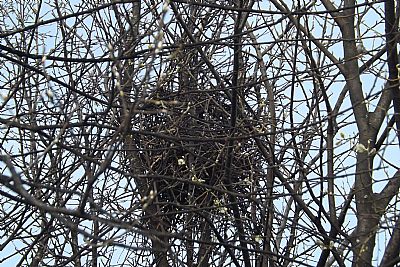
A magpie nest in Lomond Industrial Estate. Other corvid nests are similar. Note the jumble of twigs with a hollow on top.

Here we have jackdaw niests. Lots of them in a rowdy neighbourhood.
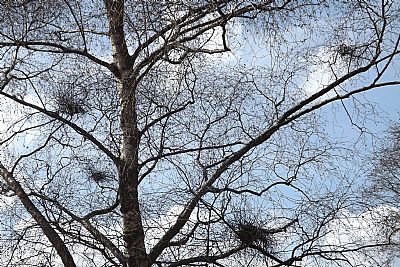
Don't confuse mistletow for crow nests. They look so similar in winter. These are clusters of living although dormant growth with straggling bits hanging down.
If you have even the slightest of interest in thie amazing range of birds, give yourself a treat and get hold of this book : Corvus: A Life With Birds by Esther Woolfson. You will be even more impressed by them and even endeared to them. The following is taken directly from the promotional wording for the book.
One spring, many years ago, Esther Woolfson's daughter rescued a fledgling rook. That rook, named Chicken, quickly established herself as part of the family, and other birds, including an irascible cockatiel and a depressive parrot, soon followed. But it was the corvids - members of the crow family - who amazed Woolfson with their personality and their capacity for affection. This classic blend of memoir and natural history combines the author's fascination with all things avian, from the mechanics of flight to the science of birdsong, with her funny, tender stories of life among the birds. [Amazon].
The rook Chicken was adopted by Woolfson as a fledgling and she began feeding the bird a diet of minced meat, eggs, and nuts. Chicken's full name is Madame Chickeboumskaya, after an American drag queen. Chicken has a habit of hoarding food in boot laces, using a table to incubate infertile eggs, and following Woolfson around the house. The rook is able to go wherever she wants to in the house and she "sleeps, bathes, roosts, and preens" in Woolfson's office. Chicken acts similar to a cat or dog and was 18 years old when the book was written. [Wiki].
You can find more about these by following these links:
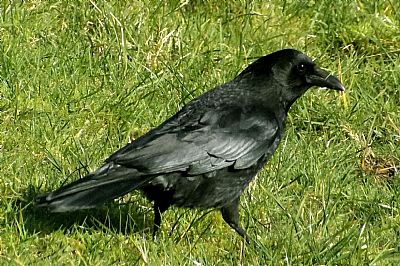
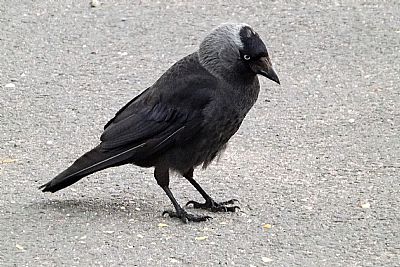
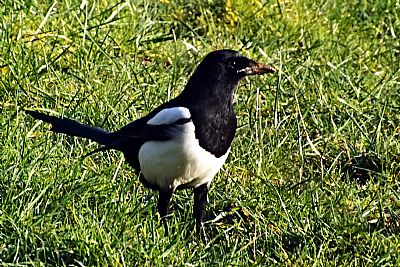
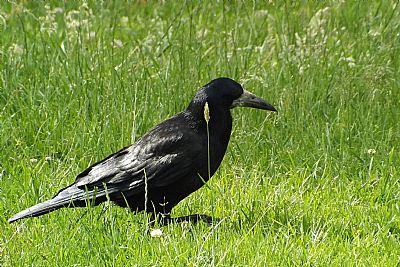
BIRD FACT website : https://birdfact.com/articles/crow-symbolism
BIRD HYBRIDS website : https://birdhybrids.blogspot.com/2014/06/carrion-crow-x-hooded-crow.html
COUNTRYFILE website : https://www.countryfile.com/wildlife/birds/british-crow-guide-how-to-identify-each-species-and-where-to-see/
DISCOVER WILDLIFE website : https://www.discoverwildlife.com/animal-facts/birds/corvids-of-the-british-isles/
THE GUARDIAN : A murder of crows: Chris Packham and the countryside war over bird killings : https://www.theguardian.com/environment/2019/may/14/a-of-crows-chris-packham-and-the-countryside-war-over-bird-killings
RSPB : https://www.rspb.org.uk/birds-and-wildlife/wildlife-guides/bird-a-z/crow-family/ This differentiates between the crow types and gives detail information on each.
WIKIPEDIA : https://en.wikipedia.org/wiki/Corvus & https://en.wikipedia.org/wiki/Ravens_of_the_Tower_of_London

